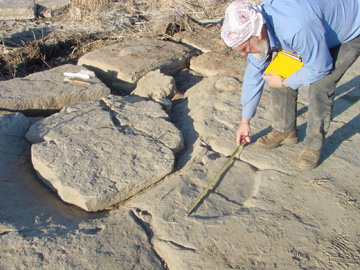
Geotimes Home | AGI Home | Information Services | Geoscience Education | Public Policy | Programs | Publications | Careers

 Katherine McCarville,
a geology Ph.D. candidate at the South Dakota School of Mines and Technology concentrating
in vertebrate paleontology, thinks she may have found the answer serendipitously
after watching the movie Walking with Dinosaurs in which a Postosuchus is shown
relieving itself in an act of marking its territory. Although some paleontologists
were annoyed with this speculated caricature of the animal, McCarville thought
the film raised an intriguing question, and one she might be able to solve. She
had recently investigated a shallow, bathtub-sized depression among the trackways
of the Purgatoire Valley in southern Colorado as part of a field trip to the Picketwire
Canyonlands.
Katherine McCarville,
a geology Ph.D. candidate at the South Dakota School of Mines and Technology concentrating
in vertebrate paleontology, thinks she may have found the answer serendipitously
after watching the movie Walking with Dinosaurs in which a Postosuchus is shown
relieving itself in an act of marking its territory. Although some paleontologists
were annoyed with this speculated caricature of the animal, McCarville thought
the film raised an intriguing question, and one she might be able to solve. She
had recently investigated a shallow, bathtub-sized depression among the trackways
of the Purgatoire Valley in southern Colorado as part of a field trip to the Picketwire
Canyonlands.  |
Geotimes Home | AGI Home | Information Services | Geoscience Education | Public Policy | Programs | Publications | Careers |